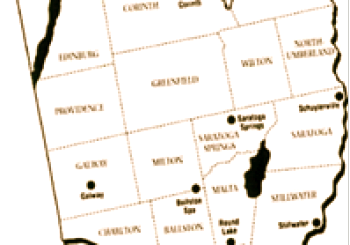Early Saratoga County History

Saratoga County lies in the northwest angle formed by the junction of the Hudson and the Mohawk rivers. The eastern and southern sweep of the Hudson outlines the north and eastern boundaries, while part of the southern line runs through the center of the Mohawk. For seventy miles, from the narrow gorge of Luzerne, rushing over the precipitous Palmer’s Falls, and again leaping the “cavern-haunted” Glenn’s Falls, the Hudson suddenly turning south fights its way through the Hillside region, named by the Indians Se-rach-ta-gue, meaning “the hillside country of the great river.” Another Indian title for the area, suggested perhaps by the contrast between the boisterous waters of this section with Stillwater a few miles further down, was Sa-ragh-to-ga, which being interpreted, meant “the place of the swift water.”
The valleys of the streams, the softened ranges of the lower Adirondacks, the last elevations of the Palmertown mountains, make the beautiful setting for the “Queen of Spas,” and has been given one of the few Indian titles among the divisions of New York State, Saratoga.
The county is historic ground. When Plymouth Bay was still unknown, the Iroquois were struggling to hold this territory. The armies of the French and English marched and countermarched along the trails through the hills. The defeat of Burgoyne within the boundaries of Saratoga, in 1777, was one of the decisive battles of the New World; it was the beginning of the end of the Revolution. There is not space in this sketch for the story of the county’s part in the settlement and the establishment of a nation.
In 1684 Philip Schuyler and six other residents of Albany purchased from the Indians the region called by them Sa-ragh-to-ga, the grant being confirmed by the English government. On October 6, 1784, the favorite hunting ground of the Mohawks, Kay-ad-sos-se-ra, was sold by them to the province of New York, but it was not until two years later that the deed was confirmed by the tribes. The latter section makes up the western half of the present county. Here were the mineral springs, to which the wild animals from great distances came to drink, and here it is that the famous villages, Saratoga Springs and Ballston Spa, are located.
Years before the Indians had relinquished control of their lands, white families had settled in various parts of the county. The Dutch were the pioneers; it is thought that they came into this region shortly after their settlement of Albany. They were located in the southeastern part of Saratoga, near Waterford. A few French families, certain Canadians, others from the British Isles, came in the early years. But the situation of the land along the great thoroughfares of that day, over which the opposing military parties were continually passing, prevented any permanent settlement. Immediately after the conquest of Canada, in 1760, there was a great influx of pioneers, and from this date on, checked a bit by the Revolution, the hunting grounds of the Indians took on the semblance of a white man’s State.
Of the public works that helped much in the development of the county, the Champlain Canal was the first, it extending along the Hudson from Waterford to the south border of Northumberland. The Erie Canal, a few years later, 1825, was not particularly valuable to Saratoga. The Saratoga and Schenectady Railroad was of major assistance, for its completion, in 1833, opened an easy way to Saratoga Springs, which was already an old, blase’ health resort.
While the soil of Saratoga County is not notably good, and the district has always been prominent among the agricultural sections of the State, the main natural resource of the county, especially in the beginning, was the mineral springs of the central part. General Schuyler had cut a road from his farm at old Saratoga to High Rock Spring in 1777. Washington had visited the general in 1783, and was so impressed with the country and the value of the waters that he wanted to buy the property, but others had already secured it. In 1791 Gideon Putnam had cleared a farm at Saratoga, and Governor Gilman, of New Hampshire, in 1792, had discovered Congress Spring. Putnam built a large boarding house, so that before the nineteenth century had been ushered in Saratoga Springs was a fashionable health resort.

